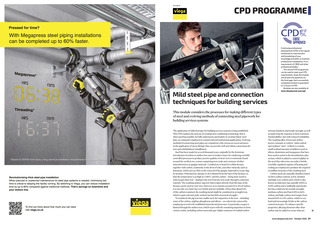


SPONSOR CPD PROGRAMME Mild steel pipe and connection techniques for building services Continuing professional development (CPD) is the regular maintenance, improvement and broadening of your knowledge and skills, to maintain professional competence. It is a requirement of CIBSE and other professional bodies. This Journal CPD programme can be used to meet your CPD requirements. Study the module and answer the questions on the final page. Each successfully completed module is equivalent to 1.5 hours of CPD. Modules are also available at www.cibsejournal.com/cpd This module considers the processes for making different types of steel and evolving methods of connecting steel pipework for building services systems The application of mild steel pipe for building services systems is long established. This CPD explores the process of creating steel, explaining terminology that is often used but possibly not fully understood, particularly in creating black steel pipe, as commonly employed in commercial and institutional applications. Evolving methods of connecting steel pipes are considered, with a focus on recent advances in the application of press-fittings that can provide swift and robust connections for new and refurbishment installations. Steel has been made for several thousand years, originally by the fortuitous introduction of carbon to molten iron and, in modern times, by employing carefully controlled processes to produce precise qualities of steel. Iron is commonly found around the world as ore, a stone comprising iron oxide and a mixture of other minerals known as gangue minerals. Crushed ore is heated in a blast furnace together with carbon, commonly in the form of coke, and other minerals, such as limestone, which acts as a flux in the removal of the gangue materials to create slag by-product. Preheated air, and gas or oil, is blasted from the base of the furnace, so that the temperature is as high as 1,700C, and the carbon being more reactive with oxygen than iron displaces the iron from the iron oxide through a reduction reaction. The resulting molten pig iron that is taken directly from the base of the furnace can be used as cast iron. However, as it contains around 2% to 4% of carbon, it is not only very hard, but very brittle and not weldable. (If less than about 0.1% of the carbon remained, the resulting metal might be considered as wrought iron, which is quite soft and easily worked, but has little structural strength.) To transform the pig iron into usable steel, the impurities in the iron including some of the carbon, sulphur, phosphorus and silicon are selectively removed by employing several well-established minerals and processes. In particular, oxygen is blasted through the molten iron, which reacts with the remaining impurities to form various oxides, including carbon monoxide gas. Higher amounts of residual carbon increase hardness and tensile strength, as well as improving the response to heat treatment (hardenability), but with reduced weldability. The resulting alloy of iron and carbon known variously as carbon, plain carbon and ordinary steel is likely to contain small residual amounts of additives such as silicon, aluminium and manganese that have been used to assist in the deoxidisation, plus cerium, which is added to control sulphur in the steel that otherwise can make it brittle. Carefully regulated regimes of heating and cooling are employed to produce the required crystalline structure of the resulting steel. Carbon steels are typically classified, based on their carbon content, as low, medium and high. Low-carbon steel, which is also known as mild steel, has typically 0.05% to 0.25% carbon and is malleable and ductile, but has a relatively low tensile strength; medium-carbon steel has 0.25% to 0.6% carbon; and high-carbon steel ranges from around 0.6% to 1.5% carbon, which is very hard and increasingly brittle as the carbon content increases. To enhance specific properties, alloying elements other than carbon may be added to create what are www.cibsejournal.com October 2022 81 CIBSE Oct 22 pp81-84 CPD 203.indd 81 26/09/2022 15:27